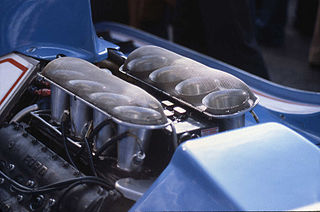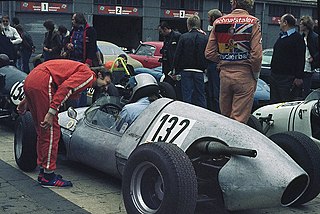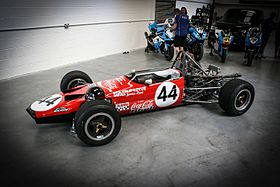
Cosworth is a British automotive engineering company founded in London in 1958, specialising in high-performance internal combustion engines, powertrain, and electronics for automobile racing (motorsport) and mainstream automotive industries. Cosworth is based in Northampton England, with facilities in Cottenham England, Silverstone England, and Indianapolis IN US.

The Ford Kent is an internal combustion engine from Ford of Europe. Originally developed in 1959 for the Ford Anglia, it is an in-line four-cylinder overhead-valve–type pushrod engine with a cast-iron cylinder head and block.

Formula Two is a type of open-wheel formula racing category first codified in 1948. It was replaced in 1985 by Formula 3000, but revived by the FIA from 2009–2012 in the form of the FIA Formula Two Championship. The name returned in 2017 when the former GP2 Series became known as the FIA Formula 2 Championship.

Formula Three, also called Formula 3, abbreviated as F3, is a third-tier class of open-wheel formula racing. The various championships held in Europe, Australia, South America and Asia form an important step for many prospective Formula One drivers.

The DFV is an internal combustion engine that was originally produced by Cosworth for Formula One motor racing. The name is an abbreviation of Double Four Valve, the engine being a V8 development of the earlier four-cylinder FVA, which had four valves per cylinder.

The 1972 Formula One season was the 26th season of the FIA's Formula One motor racing. It featured the 23rd World Championship of Drivers, the 15th International Cup for F1 Manufacturers and numerous non-championship Formula One races. The World Championship season commenced on 23 January and ended on 8 October after twelve races.

The 1970 Formula One season was the 24th season of the FIA's Formula One motor racing. It featured the 21st World Championship of Drivers and the 13th International Cup for F1 Manufacturers. Thirteen races were held between 7 March and 25 October, with the Drivers' Championship won by Jochen Rindt and the Constructors' title by Lotus. Rindt died four races before the end of the season, but had earned enough World Championship points that no other driver managed to surpass his total by the end of the season. It is the only season to date in which the World Drivers' Championship title had been awarded posthumously. Jacky Ickx driving for Ferrari finished the season strongly, but his low 4th-place finish in the penultimate round ensured that Rindt's title lead would stand. In the end, all of Rindt's 45 points came from his five wins in the season.

Formula Junior is an open wheel formula racing class first adopted in October 1958 by the CSI. The class was intended to provide an entry level class where drivers could use inexpensive mechanical components from ordinary automobiles. The idea to form the new class came from Count Giovanni "Johnny" Lurani who saw the need of a class for single-seater racing cars where younger drivers could take their first steps. It is often speculated that this class was founded as a reaction to Italy's lack of success in the 500cc Formula Three, and although Italian marques dominated the first year of the formula, they were soon overtaken by British constructors.

The Lotus 32 was a Formula 2 racing car built by Team Lotus in 1964. It was developed from the Lotus 27 Formula Junior model. Twelve cars were produced, four of which were run by Ron Harris Team Lotus, whose drivers included Jim Clark and Mike Spence. Spence won the 1964 Autocar British Formula 2 Championship while Clark was fourth in the Trophées de France Championship.

The Lotus 49 was a Formula One racing car designed by Colin Chapman and Maurice Philippe for the 1967 F1 season. It was designed around the Cosworth DFV engine that would power most of the Formula One grid through the 1970s. It was one of the first F1 cars to use a stressed member engine combined with a monocoque to reduce weight, with other teams adopting the concept after its success. It also pioneered the use of aerofoils to generate downforce.

The Lotus 18 was a race car designed by Colin Chapman for use by Lotus in Formula Junior, Formula Two, and Formula One.

The Brabham BT49 is a Formula One racing car designed by South African Gordon Murray for the British Brabham team. The BT49 competed in the 1979 to 1982 Formula One World Championships and was used by Brazilian driver Nelson Piquet to win his first World Championship in 1981.

The Lotus 23 was designed by Colin Chapman as a small-displacement sports racing car. Nominally a two-seater, it was purpose-built for FIA Group 4 racing in 1962–1963. Unlike its predecessors Lotus 15 and 17, the engine was mounted amidship behind the driver in the similar configuration developed on Lotus 19.

The Clubman is a class of prototype front-engined sports racing cars that originated in Britain in 1965 as a low-cost formula for open-top, front-engined roadgoing sports cars like the Lotus 7, which had been crowded out of the mainstream by rear-engined cars such as the Lotus 23.

The McLaren M7A and its M7B, M7C and M7D variants were Formula One racing cars, built by McLaren and used in the world championship between 1968 and 1971. After two relatively unsuccessful years of Formula One competition, the M7A was used to score McLaren's first win at the 1968 Belgian Grand Prix.

The Lotus 22 was a racing car built by Lotus cars in 1962, and a total of 77 cars were built. It was developed from the 1962 Lotus 20, with the major differences that it had disc brakes all round, a top link and the 'rubber donut' to the rear suspension and a dry sump engine that was canted over to lower the centre of gravity. Also notable is the smoother bodywork covering the engine, compared to the boxy design of the 20.
Four-wheel drive (4WD) has only been tried a handful of times in Formula One. In the World Championship era since 1950, only eight such cars are known to have been built.

The March 701 is a Formula One racing car model, designed by Robin Herd with Peter Wright, and built by March Engineering. The 701 was March's first Formula One design – following their one-off March 693P Formula Three prototype of 1969 – and was designed and built in only three months. The March 701 made its race debut a month after its public unveiling, at the 1970 South African Grand Prix. In total, eleven 701s were constructed, with March supplying many privateer entrants as well as their own works team. The 701's career started well, March drivers taking three wins and three pole positions from the car's first four race entries, but lack of development through the 1970 Formula One season resulted in increasingly poor results as the year wore on. The 701 was superseded by the March 711 in 1971, and made its last World Championship race appearance at the 1971 Italian Grand Prix.

The Lotus 69 was an open-wheel formula racing car developed by Lotus in 1969 for use in Formula 2, Formula 3, and Formula Ford.

The Brabham BT21 was an open-wheel formula racing car, designed, developed, and built by Brabham in large numbers in 1966 and delivered to private individuals; 110 vehicles were manufactured.























